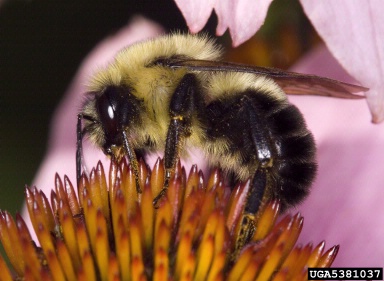|

|
|
In the late
1990′s, bee biologists started to notice a decline in the abundance and
distribution of several wild bumble bee species. Five of these species (western
bumble bee,
rusty patched bumble bee,
yellowbanded bumble bee and the American bumble bee) were once very
common and important crop pollinators over their ranges.
Franklin's bumble bee was historically found only in a small area in
southern Oregon and northern California, and it may now be extinct. The
dramatic decline in wild populations of these five species occurred
about the time that a disease outbreak was reported in populations of
commercially raised western bumble bees, which were distributed for
greenhouse pollination in western North America. The timing of this
suggests that an escaped exotic disease organism may be the cause of
this widespread loss.
This hypothesis
was supported by a recent study led by Sydney Cameron, Ph.D., published
in the Proceedings of the National Academy of Sciences. They found that
the western bumble bee and the American bumble bee had significantly
higher infection rates from a fungal parasite than more stable species.
They also found that these two species had lower genetic diversity than
species that were not in decline. Research is currently underway in Dr.
Cameron's lab to determine whether or not this fungal parasite was
introduced from Europe via the commercial bumble bee trade. You can read
more about their study and its implications
here.
A major threat
to the survival of these wild bees may be the spread of diseases from
commercially produced bees that are transported throughout the country.
The Xerces Society is currently working to urge the USDA Animal and
Plant Health Inspection Service to regulate the commercial bumble bee
trade. You can read a
status review that includes more details on this issue and the
decline of three bumble bees that was written by Dr. Robbin Thorp and
The Xerces Society. |
|
|
Articles & Research:
Patterns
of widespread decline in North American bumble bees (Cameron
et al. 2010)
Does Pathogen Spillover from Commercially Reared Bumble Bees Threaten
Wild Pollinators? (Otterstatter et al. 2008)
Signs of Decline: First Honeybees, Now Bumblebees
(Washington Post 2008)
General Information:
Bumble Bees
in Decline (Xerces Society)
Bumble Bee Conservation: Protecting North America's Disappearing Pollinators
(Xerces Society 2010)
Conserving Bumble
Bees: Guidelines for Creating and Managing Habitat for America's Declining
Pollinators (Xerces Society 2012)
Wild pollinators of eastern apple orchards and how to conserve them
(Cornel University 2012)

Bombus impatiens
David Cappaert, Michigan State University,
Bugwood.org
|


